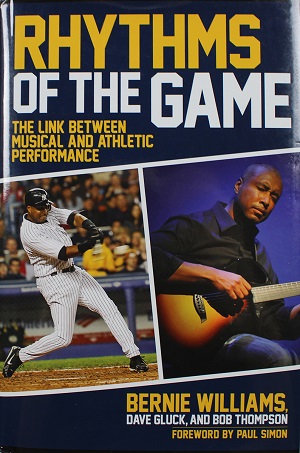
In December 2007, ex-Yankee centerfielder Bernie Williams enrolled in a "myriad" of classes at SUNY Purchase intending to improve his guitar and composition skills. He wanted to focus full-time on his music career. Bob Thompson became William's dean and Dave Gluck became his composition teacher. The idea for "Rhythms of the Game" grew out of an alumni event where all three spoke about the parallel mindsets of baseball players and musicians.
The book stresses mental strategies. In the preface, Paul Simon describes how "You're outside looking in, inside your own world of calm but heightened awareness. The world of 'the zone'... The world changes shape to suit the will of its inhabitants." According to Bernie Williams, "Being 'in the zone' is a rarified place where your preparation and experience, coupled with you intuition, bring you to a higher realm: your body is relaxed but working at peak efficiency -- your mind is clear, calm, and focused -- and despite a roaring crowd in their seats, you are totally in a Zen-like state of command. You're so focused and locked in that time seems to slow down."
Both ballplayers and jazz musicians spend an enormous amount of time mastering the mechanics of their trade so that when they perform, they can use their intuitive and creative right brain to transform routine into artistry. They learn to stay away from "negative programming" as that leads to a fall in confidence. "Can I really do that?" gets interpreted by the subconscious as that you don't think you can. If you say something is "hard," it will soon become so. Better to say "challenging" than "difficult."
The authors provide copious practical tips. Mr. Williams talks about reducing the variables. Before a batter faces a pitcher, he should learn about the pitcher's repertoire and style. In music, Dave Gluck talks about separating out a difficult passage and perfecting it by playing it very slowly at first and then gradually speeding up. Batters can focus on their swing mechanics by first hitting a slow, underhand throw. Later, they can slowly speed up the pitch. The authors focus on the difference between practicing and performing. They suggest overcoming the "fear of success" by facing it and continuing to perform. Practicing with distractions helps prepare for the roar of the stadium. They prescribe shutting down and "rebooting" to overcome a slump. They emphasize how failure can provide the key to success.
The chapter called "The Singing Bat" truly amazed me. Melvin Mora, who played for the Baltimore Orioles, could follow a ball simply by hearing the sound it made when it hit the bat. On a sharp crack, he raced out and on a dull clunk he ran in.
In many ways, baseball and music appear similar. But I find a number of important differences. Baseball is built upon deception -- the pitcher tries to strike out the batter through the use of the fastball as well as the changeup. I don't see that in music. In baseball, a batter fails two thirds of the time -- if he's really good! A musician who misses that many notes would never work! And sadly, for Mr. Williams and his peers, no one can play MLB into old age. It makes too many demands on the body. On the other hand, look at the Rolling Stones. They show no signs of slowing down.
©2012 Roger Zee